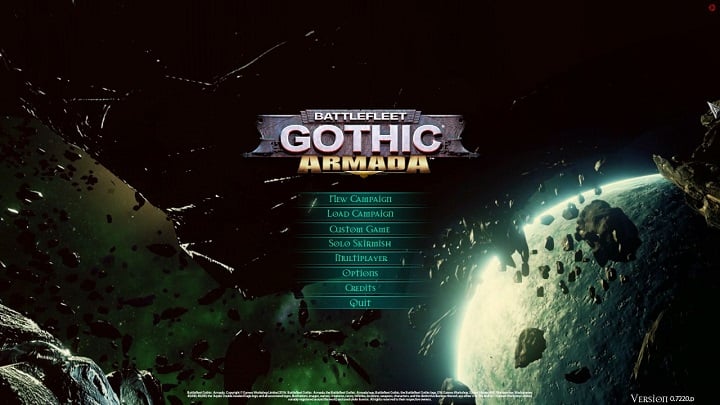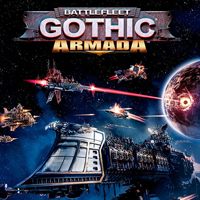Battlefleet Gothic Armada: Game modes and factions
Game modes
Battlefleet Gothic Armada is a real-time strategy game set in the universe of Warhammer 40,000. The game offers both a multiplayer mode and an extensive single player campaign. Within the solo mode, you have three options: Campaign, Custom Game, and Skirmish. The best way to get to know all the gameplay mechanics is to begin with the campaign. After completing the campaign you can play through the skirmish mode, where the missions are unrelated to the plot, but you can play as each of the available parties to the conflict from the very beginning. Missions in this mode are randomly generated, based on the player's level. After creating a profile for a particular nation, you can use it to play a custom game. When creating a profile for each of the game modes and factions, you will be able to choose the level of difficulty for the campaign or skirmishes. Novice players should choose between easy and normal difficulty. Experienced players can try their hand at higher levels or in PvP.

Available factions
The game offers four parties to the conflict. The fleet of each faction is characterized by diverse units that have certain characteristics in common. Different options of ship customization are available to different factions..
Empire
- Have a powerful Nova Cannon, effective at long range
- All units are heavily armored on the bow
- Many units have torpedoes with unlimited range
- Basic guns of their ships are ineffective at long range
- Ships are slow and not very maneuverable
The imperial fleet is slower than the other factions, but nearly immune to enemy attacks from the front. Larger ships are armed with Nova Cannon, which can inflict a lot of damage, but it is best to use it against fixed targets. It has a large spread so be careful when firing. Many units are equipped with torpedoes that cross the battlefield in a straight line after launch. Their effectiveness is increased when enemy ships are in mid-range and head directly towards the ship that fired the torpedoes. Due to the ships' limited maneuverability it is best to remain close to the enemy while watching out for ramming attempts and not letting your ships be surrounded.
Chaos
- The vessels are extra effective at long distances
- Units are fast
- Basic guns do little damage
- Weak armor and a limited number of ships armed with torpedoes
The chaos fleet can quickly close in on the enemy and is able to sustain fire in mid-range over extended periods of time. Despite their high rate of accuracy, damage inflicted by the basic guns is low. Their units lack heavy armor and are quickly destroyed at close range. Due to the small amount of torpedoes, they are unable to weaken the enemy resources before engaging in direct combat. The basic tactic is to avoid collisions with enemy ships and carry out continuous shelling from long distance.
Orcs
- Able to customize many ships
- Units are difficult to detect
- Overwhelming at close range
- Liable to insubordination
- Limited maneuverability and low accuracy at mid to long range
The Orc fleet was made for boarding and ramming. Thanks to very silent movement, they can manage to surround enemy units and board them or quickly destroy. Many ships can be adapted to specific situations on the battlefield. In the case of a failed action or when receiving significant damage, individual ships often flee from the battle. The units have a large tonnage, which facilitates the ramming, but after a failed charge it is hard for them to turn around.
Eldar
- The fastest and the most agile units in the game
- Crews are very loyal to their commander
- Ships are very susceptible to ramming
- Most of the armament is located on the bow
- Very susceptible to boarding
The Eldar fleet can move around the battlefield in an instant. Able to change course quickly and move away to a safe distance. In most cases, the ships are fighting to the end, having very little tendency to insubordination. The essence of fighting as the Eldar, is to maintain enough distance to prevent boarding attempts and constantly change ships' positions. The units are very susceptible to damage, although their significant base speed allows them to withdraw from the battle and carry out the necessary repairs.
- Battlefleet Gothic: Armada Game Guide
- Battlefleet Gothic Armada: Game Guide
- Battlefleet Gothic Armada: Gameplay basics
- Battlefleet Gothic Armada: The HUD
- Battlefleet Gothic Armada: Game modes and factions
- Battlefleet Gothic Armada: Experience
- Battlefleet Gothic Armada: Types of missions
- Battlefleet Gothic Armada: Forming the fleet
- Battlefleet Gothic Armada: Controls; unit deployment
- Battlefleet Gothic Armada: System requirements
- Battlefleet Gothic Armada: Gameplay basics
- Battlefleet Gothic Armada: Game Guide
You are not permitted to copy any image, text or info from this page. This site is not associated with and/or endorsed by the developers and the publishers. All logos and images are copyrighted by their respective owners.
Copyright © 2000 - 2025 Webedia Polska SA for gamepressure.com, unofficial game guides, walkthroughs, secrets, game tips, maps & strategies for top games.
